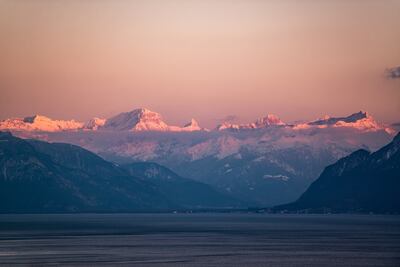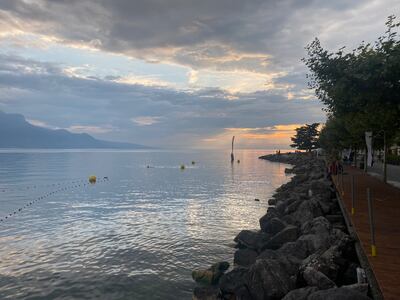“You never grow bored of Lake Geneva, it looks different every day,” is a phrase that was said to me more than once during my visit to the attraction.
I was in the canton of Vaud, on the Swiss side of the body of water overlooked by the Alps, for five nights, and it was more than enough time to be charmed. Every day of my stay, the lake had an entirely different feel. On a brisk but sunny day, light bounced off the water and I was almost tempted to take a dip — although my years being spoiled by the warm seas of Dubai put a stop to that; I am nowhere near Wim Hof enough any more. On an overcast day, it had the atmospheric feel of a Caspar David Friedrich painting; and on a windy day, there were crowds of sailing boats out, darting across the waves.
It did not take me long to understand why Mary Shelley, Lord Bryon and more Bohemians were drawn to the area in the 19th century. Or why some of the greatest stars of the 20th century chose to call it home — Freddie Mercury, Charlie Chaplin and Audrey Hepburn all resided on the lake. Even today, the likes of Shania Twain, the Schumachers and Sophia Loren all call Vaud home.

Navigating Vaud
Like most major European cities, you essentially have two options when it comes to making your way out of Geneva Airport: public transport or taxis. It is no secret that Switzerland isn’t the cheapest of destinations, so public transport is a more wallet-friendly way to start a Swiss stay. It could not be easier to navigate your way out of the international airport and on to the national rail system, thanks to the station inside the airport, a short walk from arrivals. From the UAE, both Etihad Airways and Emirates fly direct to Geneva.
My first stop was the city of Lausanne; a CHF29 ($31) and the 45-minute journey took us to the heart of the hilly city.
There is clearly a drive to get tourists travelling by public transport within Vaud. In Lausanne, Montreux and Vevey, with the booking of any hotel or holiday rental that pays tourist tax, visitors receive complimentary city transport tickets.
Indulging in chocolate and cheese
Switzerland’s most famous exports are well documented: watches, utility knives, cheese and chocolate. My budget doesn’t extend to a Rolex and I am already the proud owner of a Swiss Army knife, so for this trip, my focus was on the indulgent Cs: cheese and chocolate.
This was my first trip to the country, and before I went, I was told by friends that “chocolate just tastes different there”. They aren’t wrong. A visit to the Durig chocolate boutique in the heart of Lausanne had me won over and weighed down with 500-gram blocks of 80 per cent cocoa heaven.
For a cheese fix, a visit to the Lausanne farmers market on Wednesdays and Saturdays is a must. In Rippon Square in La Cite, I enjoyed a cheese stall crawl of sorts, hopping from pop-up stand to pop-up stand, sampling locally-made Gruyere, raclette and tomme cheeses, and trying to resist buying it by the wheel.

Another sure-fire way to get a cheese fix is fondue. As the evenings get colder and darker, this is a popular Swiss meal and pastime. We had a reservation at Pinte Besson. Founded in 1780, it is one of the oldest fondue restaurants in Lausanne, where hours were lost eating charcuterie meats and cheeses, and dipping bread and potatoes into the indulgent pot of melted cheeses.
Another C of note to watch out for in the Canton De Vaud is chasselas, the grape grown in Lavaux. Even if you’re not a wine drinker, a trip on the Lavaux Express tourist train through the steep vineyards is a stunning day out, enjoying the view of endless rows of vines while overlooking the lake.

Checking into the Royal Savoy
In Lausanne, I stayed at the Royal Savoy, a charming inner-city hotel that has been newly renovated. From the outside, you feel like you’re stepping into a grand manor house, and inside it’s a slick and modern hotel with a boutique feel.
The rooms are not enormous but are cosy and beautifully decorated, with a spacious bathroom. The majority of standard rooms come with a walk-in shower and no balcony. When it comes to vistas, they are split between those with a city and lake view.
Catering to global travellers, the television in the room had English, Arabic, German and French options.
On the ground floor is La Brasserie du Royal, a modern restaurant where we enjoyed a stunning meal on the first night of our stay. But the hotel’s crown jewel is SkyLounge, a rooftop spot that boasts panoramic views of Lake Geneva. A sunset reservation is essential when you’re in Lausanne, whether you’re staying at the Royal Savoy or not. Watching the sky shifting through shades of orange, purple, red and navy blue was the perfect way to end a day exploring a new city.

Exploring Lausanne
The metro will take you pretty much anywhere in Lausanne. For a day of culture, get on at Delices, which is opposite the Royal Savoy, and get off at Bessieres to see the sights and sounds of the older parts of the city at the top of the hill.
Lausanne has the feel of a charming town, while proudly standing as the fourth biggest city in Switzerland. When you get off the metro in Bessieres, cross Pont Bessieres, which was built in 1910 and is the highest bridge in the city. You’ll arrive at the cathedral, which is striking and atmospheric; the 13th-century stained glass window is a stunningly preserved feature.
Make your way down the market stairs to Place de la Palud on the hour, where a musical clock chimes hourly, telling the story of the Canton De Vaud through song.
Lose a day on Lake Geneva

Lake Geneva is at the heart of life in the canton. In warmer months, an hour or so on a pedalo is a great way for tourists to proverbially and literally dip their toe into the lake, without committing to a sailing boat.
For a grander experience, book a lunchtime cruise on one of the Belle Epoque steamboats. Leaving from Lausanne, we travelled to the far end of the lake, seeing the vineyards of Lavaux, the towns of Vevey and Montreux, and the famed Chillon Castle, all while dining on a three-course lunch which consisted largely of locally sourced seafood.
We ended the cruise in Vevey, the next stop on our Lake Geneva journey, but could have taken it back to Lausanne for a round day trip.
The winding alleyways of Vevey and musical Montreux
Vevey is a thriving town, set directly on the lake. Give yourself half a day to get lost in its winding streets, browsing the many antique shops and stopping for the odd coffee or chocolate, hot or cold.
In the warmer months, the Montreux Riviera is perfect for a dip in the lake, with cordoned-off swimming areas and ladders into the water. For those who want to stay dry, along the Vevey shore are decked areas where you can sit and enjoy a drink, and chairs built into the rocks, to sit and fish from, or just admire the view.

A reservation at Ze Fork is a must. The lakeside restaurant is named after the fork-shaped sculpture in the lake, the Fork of Vevey, created by Swiss artist Jean-Pierre Zaugg in 1995 to honour the Alimentarium food museum's 10th anniversary. The restaurant serves modern Swiss cuisine and was rated by more than one local as their favourite in the area.
Nearby is Montreux, a town steeped in musical history, thanks to the famed Montreux Jazz Festival. The likes of Nina Simone, Miles Davis, Ella Fitzgerald, Prince, Leonard Cohen and David Bowie have all played at the festival. In 1971, the town was the site of a fire, which was immortalised in song by Deep Purple, which penned Smoke on the Water about the incident. In 2021, a pared back version of the festival was held in predominantly outdoor venues, but it is hoped it will be back in full force in 2022.

Freddie Mercury is a famous former resident of the town. It was in Queen’s legendary Mountain Studios that he recorded his final vocals before his death in 1991 and his time in the town is honoured with a giant statue that looks out over the lake.
Visit the Queen Studio Experience for a mini-museum dedicated to the band, which has famous costumes and handwritten lyrics exhibited, and a plaque to mark the spot where Mercury stood during his last recording session.
At home with Charlie Chaplin
For fans of cinema, a visit to Chaplin’s World is a must. Famed silent film star Charlie Chaplin spent his later years living near Lake Geneva, after his US residency was revoked in 1952.
Until his death in 1977, he lived with his family in a stunning manor house, set in a spacious plot of land overlooking Lake Geneva. It has since been converted into a museum that meticulously details the English actor’s life and career.

Split into two sections, the house tracks the actor’s life and a second building details his career. The main residential building is still set up like a family home, which tells Chaplin’s story through a series of informative digital attractions and immersive room displays as you move from the study to the living room, dining room, bathroom and bedroom.
The Studio is a newer building. Experiences begin in a large cinema, and you are then able to walk through life-size silent film set recreations in a Hollywood-style studio.
Tickets for Chaplin’s World cost 27 Swiss francs.
Covid-19 in Switzerland
At the time of writing, masks are mandatory on public transport, but they are not required when outside. As of February 17, they are no longer required in shops and supermarkets.
Per the new rules, travellers can enter Switzerland without any Covid‑19 requirements, such as pre‑departure testing, vaccination or the need to complete passenger locator forms.
To return to the UAE, a PCR test still needs to be taken within 72 hours of your flight. Tests can be booked and taken in pharmacies and cost around 125 Swiss francs.






